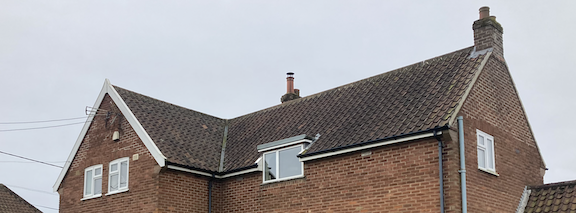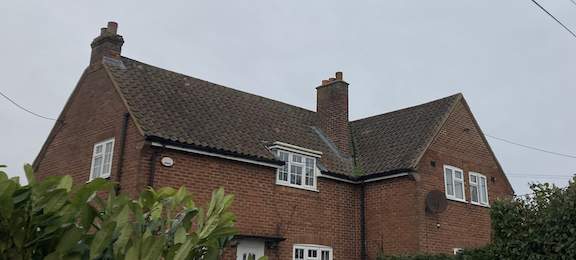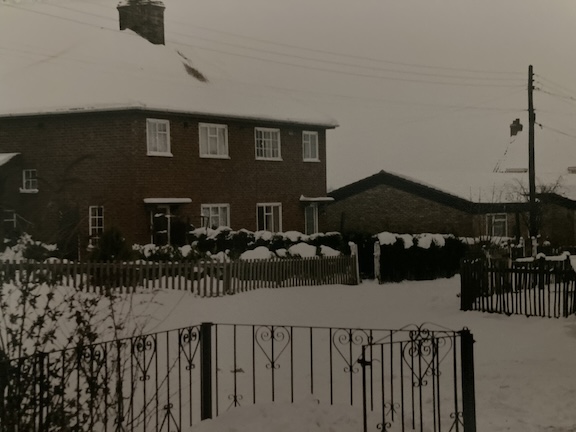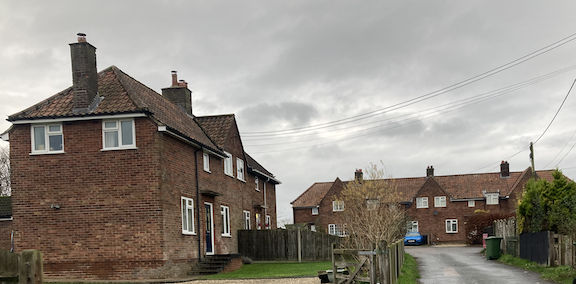The first known ‘council houses’ or ‘houses for the working class’ were built in Mill Lane. Around 1928, Wayland Rural District Council (Wayland RDC) commissioned a terrace of four houses in Mill Lane. The Council also built a pair of semi-detached houses near to the terrace, which were either built at the same time or within a year or so of the terrace.
By 1937, Wayland RDC were making plans for the construction of several more council houses in the area as part of a New Housing Programme. It included six houses to be built at Hingham Road. This was followed by the construction of a further six houses.
I believe the initial six houses were the two pairs of houses which are the ones fronting the Hingham Road, and the pair of semi-detached houses are to the right of the cul-de-sac (coming from the Hingham Road). These houses are shown as existing on a later plan of architect Stanley J Wearing dated November 1938, which relates to the construction of the six further houses.


Two of the original pairs of ‘Council Houses’ built c.1938 Hingham Road

1987. One of the original pairs of ‘Council Houses’ built c.1938 Hingham Road
The initial six properties (comprising 3 semi-detached houses), were in the process of construction at the time of Wearing’s plans for the other six houses (Nov.1938). Indeed in July 1938, the foundations for these initial six houses had been laid and the walls constructed to damp course level. However, it seems strange that the style of those houses fronting the Hingham Road differs from the semi-detached houses further into the cul-de-sac. It is possible that they were designed and constructed by different architects and builders.
Extract from the Diss Express of the 12th March, 1937. This relates to the initial six houses in Hingham Road:
New Housing Programme
The Building Surveyor (Mr C Whitworth) suggested that as the first instalment of the new Housing programme to be carried out on land that was available to replace houses demolished for slum clearance and to relieve overcrowding, the Council should build twelve houses at Banham, six at Great Ellingham, four at Rocklands, six at Watton and six at Harling, making a total of thirty four. On the recommendation of the Housing Committee, the Council decided to carry out this programme and a deputation was appointed to inspect the Watton site as to its suitability.
Clearance orders were agreed on concerning four houses in School Lane, Harling, four in Shropham Lane, Hockham, and four on the Common, New Buckenham.
From the Diss Express 16th July 1937 (again relating to the initial six houses):
Wayland Rural District Council
Mr S.R. Lewis presided at a special meeting of a Wayland Rural District Council held on Monday.
The housing Committee reported that there had been no reply to the Council’s advertisement for an architectural draughtsman to assist the Surveyor temporarily, and a proposal by Mr P. St. J.B. Grigson that in order to expedite the building of houses in future, an architect should be employed instead of increasing the staff, was not pressed to a vote.
The Surveyor (Mr C. Whitworth) explained that houses were required to accommodate tenants for dwellings already condemned at Attleborough (1), Banham (8), Carbrooke (1), Great Ellingham (4), Hockham (5), Harling (5), New Buckenham (5), Rocklands (2), South Lopham (2) and Watton (5), a total of 38, and in addition, 18 houses of a larger type were necessary for the relief of overcrowding.
The committee recommended the Council to take every possible step to expedite the building of these 56 houses to carry out inspections in other parts of the district with a view to deciding what other property should be recommended for demolition and that a committee should consult with the Surveyor on Friday to enable a scheme to be prepared for the speeding up of housing matters generally. The Council approved the proposals.
The appointment of Mr C.H. Marshall, of London, as resident engineer for the construction of the Attleborough sewerage and sewage disposal works, as a weekly wage of £6, as recommended by the engineer (Mr. A.J. Martin) was agreed to.
The Rev. G.B. Chambers reported that the Town and Country Planning Committee had received the preliminary zoning proposals of the Town Planning Officer for the South Norfolk Joint Committee with regard to the Wayland rural district and the parish of Attleborough. These would be considered at a meeting of the Wayland Committee on July 21st.
Diss Express 24th September 1937 (relating to the initial six houses):
New Houses
Presenting the report of the Housing and Sanitary Committee the Rev. H. Anderson stated that the tenders of Messrs. Tennant & Son of Norwich Road, Watton, had been accepted for the erection of twenty-four dwelling houses.
These were: Ten at Winfarthing Road, Banham, £3,770; six at Hingham Road, Great Ellingham £2,175; four at Rectory Road, Rocklands £1,310; two at Jubilee Avenue, East Harling £714; and two bungalows at King Street, East Harling £577.
From the Diss Express 1st July 1938 (regarding the initial six houses):
Sanitary Inspector’s Report
….. The houses at Banham were nearing completion. The two houses at Jubilee Avenue Harling were tiled in and ready for plastering and the plastering is being carried out to the two bungalows. The Rockland houses were ready for tiling and at Great Ellingham, the concrete foundations had been laid for the six houses and walls carried up to damp course level……
Further Six Houses in Hingham Road
In November 1938, architect Stanley J Wearing drew up plans for the building of new council housing in several towns and villages in the Wayland Rural District Council area. This included a row of four terrace houses and semi-detached houses in the cul-de-sac off the Hingham Road.
The site plan drawn up at the time shows the existing six houses as well as the proposed six new dwellings. The plan also shows the position of a [water] pump and a well to the right hand side of the cul-de-sac coming from the Hingham Road.
Wearing also produced detailed specifications for the proposed houses in the towns and villages, including the specifications for the six houses in Great Ellingham. However, the specifications did not include bathrooms or inside toilets. Bathrooms were added at a much later date. Nevertheless, there were fireplaces in some of the bedrooms.
Occupants of the Initial Six ‘Council Houses’
In the meantime, the initial six ‘Council Houses’ were complete and occupied at the time of the 1939 Register for England & Wales.
| Occupier | Notes |
|---|---|
| Cursons | The head of this household is 41 year old Charles H G Cursons. With Charles is his wife Miriam and children Alan aged 11 and Raymond 8. Charles is working at a Cyder Factory. I assume Wm. Gaymer & Son in Attleborough. Charles Cursons was born in Great Ellingham on the 13th May 1898. He married Miriam Bilverstone in 1920. At the time of the 1921 census, the couple are living at Chapel Yard (Long Street), Great Ellingham. Charles was then working for local farmer, F. Southgate. Before his marriage, Charles had served as a Private with the Norfolk Regiment in WWI. |
| Giles | Another household is that of 56 year old Attleborough born John Giles. He is with his wife Nellie and two of their children, Wilfred aged 25 and Stanley aged 22. The household also includes 11 year old Mary Giles. John and his two sons are all working. John as a farm labourer, Wilfred as a general labourer at the nearby aerodrome, and Stanley is a labeller at a Cyder Works (again, presumably Wm. Gaymer & Son). |
| Newby | 52 year old Estella Newby is the head of the next household. Her husband, Frank, is not with the household when the details for the Register were taken. Nevertheless, the Newby household is large having 10 occupants (without Frank Newby!). There is Doreen Newby aged 20. She is working as a ward maid at the Infirmary (presumably the Wayland Hospital). Gladys Newby is 18 years old and she is working as a domestic servant. Basil Newby is 14 years old. 8 year old Edith Newby is at school. There is also 19 year old Doreen E Allen who is also working as a domestic servant. 34 year old bricklayer’s labourer, William Hall, is also with the Newby household. In addition, there are three other people. However their names have been redacted from the online 1939 Register as these persons may still be alive today. |
| Watling | The Watling household comprise only of 47 year old William E Watling and his mother, 68 year old Sarah Watling (known as Sally). The Register indicates that William Watling is ‘incapacitated’. In 1921, mother and son along with William’s step-sister Hilda Watling, lived in Bow Street. |
| Jude | Next we have the household headed by 33 year old cowman Basil G O Jude. Basil may well have been born in Bow Street where he is with his parents, Basil & Ada Jude, at the time of the 1911 census. By 1921, 14 year old Basil had moved with his parents to Kenninghall where his father worked for a local farmer. He married Lilian Hudson in 1936. The 1939 Register finds Basil with his 25 year old wife Lilian and son, Neville, who is just a few months old. Likely the Register also includes their first-born child, a daughter, but her details have been redacted. The couple would go on to have at least one other child. |
| Lincoln | 71 year old Great Ellingham born James Lincoln is occupying the other house along with his 69 year old wife Sarah. James Lincoln is described as ‘incapacitated’. There is another person in the household but the name has been redacted from the Register. At the time of the 1921 census, the couple are living in Town Green. Living with them is their niece, 21 year old Blanch Vince, who is working at the Parsonage as a ‘domestic’. Blanch later married James W Reeder and occupied one of the other 6 houses built in the cul-de-sac off the Hingham Road. |

The further six ‘Council Houses’
Photograph February 2025
By August 1940, the additional six dwellings were complete. A newspaper article (Diss Express 23 August 1940), provides us with the names of some of the occupiers of these new properties – Bilverstone, Hudson, Dickerson.
Extract from the Diss Express 23 August 1940:
Wayland Rural District Council
Housing Scheme - Progress Report: The report of the Housing Architect (Mr S J Wearing) on the progress made in the completion of the houses left uncompleted by Messrs. Fisher Bros., was received and approved……
Council Houses Old Buckenham Great Ellingham and Harling. The Committee considered the letting of the newly erected houses in the above parishes, together also with one house which had become vacant at East Harling, and it was decided to recommend the same to be let as under: Old Buckenham - Sturman A.H. (4 bedroom type) 5/9 per week net rent plus rates; Flat L.R. (2 bedroom) 4-per week; Hales J. (3 bedrooms) 4/6 per week. Petley H. To take house at present occupied by A.H. Sturman. Rent 3-per week plus rates. …
Great Ellingham - Bilverstone J.C. (3 bedroom type) 4/5 per week; Hudson B. (3 bedroom type) 4/6 per week; Dickerson A. (3 bedroom type) 4/6 per week. The Clerk was instructed to publish notices calling for applications for the remaining three houses at Great Ellingham. ….
From the newspaper report, it seems that there had been some delay in the completion of the houses.
However working with this information and the household information provided by the Great Ellingham Invasion Committee Record of 1942, I am able to identify the occupiers of the 12 ‘council houses’ in Hingham Road. It is worth remembering that the ‘Swedish’ style houses and bungalows, as well as the larger ‘council house estate’ were not yet built!
| Approx. Dates | Notes |
|---|---|
| 1942 | Chilleystone The Invasion Committee Record lists Mr R Chilleystone, Mrs Chilleystone and a child. Mr Chilleystone is a home guard and his wife is a member of the Women’s Voluntary Service (W.V.S.). |
| 1940 | Dickerson The name A Dickerson is mentioned in the newspaper report as an occupier of one of the (then) newly built (further) council houses. The Invasion Committee Record also lists Mr A Dickerson 57, Mrs Dickerson, Mr A Dickerson and Cecil. Mrs Dickerson is also a member of the W.V.S., Arthur Jnr. a home guard and Arthur Snr. assigned general duties. ‘A Dickerson’ is Arthur Dickerson born 16 July 1885 in Wendling. A few years earlier, the 1939 Register captures the household of widower Arthur Dickerson at Fly Bottom, Rocklands. Other members of the household are 36 year old widow Mildred M Dickerson who is described as a housekeeper. There are two children Arthur G Dickerson (soon to reach his 14th birthday) and six year old Cecil. Arthur G and Cecil are the children of Arthur Dickerson and his late wife, Dinah Louisa Maria Lister. Arthur & Dinah married in 1914 and had at least 5 children. Sadly, Dinah Dickerson died in 1936 at the age of 41. |
| 1940 | Hudson The newspaper report also mentions “B. Hudson’ as an occupier of one of the newly built houses. The 1942 Invasion Committee Record lists 5 members of the Hudson household – Mr R Hudson (home guard), Mrs Hudson (general duties), Miss B Hudson, Mr F Hudson (home guard) and Miss J Hudson. I believe reference to Mr R Hudson is incorrect and should read Mr B Hudson. In 1921, Gately born Blomfield Hudson lived with his wife & 5 children in Church Street, in a cottage opposite Mill Farm. That part of Church Street was then known as ‘The Street’. The family were still in ‘The Street’ at the time of the 1939 Register. However not long after, they moved to Hingham Road. Members of the Hudson family remained living in the house for many years. |
| 1940 | Bilverstone According to the newspaper report of 1940, another of the newly built properties is to be let to ‘J.C. Bilverstone’ at a weekly rent of 4/5d (four shillings and five pence). The 1942 Invasion Committee Record lists Mr J Bilverstone, Mrs Bilverstone (42), Miss J Bilverstone and ‘David’. Mr J Bilverstone is with the local casualty service and fire service. The 1939 Register finds farm labourer John C H Bilverstone and his wife Violet with their two children living in Hingham Road. However they were not at that time living in any of the ‘council houses’. John C H Bilverstone had married Violet Fox in 1926. Five years earlier, the 1921 census captures John living with his parents, John C & Emma Bilverstone in ‘Rose Cottage’ Great Ellingham. The same census finds 20 year old Violet with her parents, William & Ellen Fox, at ‘Sparrows Nest’ in Long Street, near Shruggs Lane, opposite Cherry Tree Farm. The cottage was much later demolished. |
| 1939 | Watling From at least 1939, mother and son, William and Sarah (Sally) Watling, occupied one of the first ‘council houses’ in Hingham Road. The couple are still there in 1942. |
| 1939 | Newby The Newby household also occupied one of the first ‘council houses’ in Hingham Road. Accordingly, I assume that they are still living in the same house. Absent from the 1939 Register, Frank Newby is listed as ‘Mr F. Newby’ on the 1942 Invasion Committee Record. It is still a large household. Along with Frank Newby, the Invasion Committee Record lists Mrs Newby, Mr B Newby, Mrs J Ellis with one child, 3 Newby children, Mr Ben Newby and Pat Allen. ‘Mr B Newby’ (Basil Newby) and Ben Newby are both with the home guard. |
| 1942 | Wigby The 1942 Invasion Committee Records lists Mr E Wigby, Mr Wigby and child occupying one of the ‘council houses’ in Hingham Road. I wonder whether ‘Mr E Wigby’ is Edward Wigby, the son of local farmer Obadiah Wigby. The Wigby family lived at Mill Farmhouse. In 1941, Edward married Esther Pease. |
| 1939 | Cursons Charles and Miriam Cursons also occupied one of the first ‘council houses’ in Hingham Road. The 1942 Register lists the Cursons household as Mr C Cursons, Mrs Cursons, Alan and Ray. Charles Cursons is with the home guard and Alan and Ray are both cadets. |
| 1939 | Giles The 1942 Register also lists Mr Giles, Mrs Giles and Mary. The household of John and Nellie Giles is also one which occupied one of the original ‘council houses’ in Hingham Road. John Giles has been assigned ‘general’ duties for the war effort and Nellie Giles is a member of the W.V.S. |
| 1939 | Lincoln James and Sarah Lincoln also occupied one of the original Hingham Road council houses. The Invasion Committee Register of 1942 lists the couple as Mr J Lincoln and Mrs Lincoln and they are both said to be ‘aged’. |
| 1942 | Reeder The Reeder family moved into one of the ‘newly built’ council houses. The Great Ellingham Invasion Committee record of 1942 lists the household in Hingham Road Council Houses as Mr W Reeder, Mrs W Reeder, John Reeder Taylor and 2 children. William Reeder is with the home guard. John Reeder Taylor is a messenger. As ‘James W Reeder’, William Reeder married Blanche K E Vince in 1921, after the census of that year. At the time of the census, William is living at his family’s home in Long Street. His future wife Blanch Vince is living with her Aunt & Uncle James & Sarah Lincoln in Town Green. I believe that John Reeder Taylor may well be William Reeder’s nephew, John Reeder. The Reeder family lived in the ‘council houses’ for several decades |
| 1942 | Newby One of the ‘council houses’ is occupied by another Newby family. The Invasion Committee Record lists Mr H Newby with Mrs Newby and 3 children. A note suggests that Mr Newby is in the army. I believe the couple to be Harry & Violet Newby. Harry Newby married Violet Male in 1937. The 1939 Register captures carpenter 27 year old Harry Newby living in Town Green with his 26 year old wife and two children. By 1942, the Newby family moved to Hingham Road. They went on to have 5 more children (including twins). Again, this family continued to live in Hingham Road for many years. |
Many Families
For over eight decades, these ‘Hingham Road Council Houses’ will have seen the comings and goings of many families. As we have seen, some of the families stayed for several decades whilst others quickly moved on.
Alterations
The houses have also been altered over the years.
When they were originally built, the fronts of the houses were enclosed by wooden fencing with gates. Much (if not all) of the original fencing has disappeared. With the connection to mains water, the water pump and well have also long disappeared. There is no evidence of the ‘path’ marked on the architect’s plan of 1938.
By the early 1970s, bathrooms were added to the houses. With the modern convenience of central heating, the coal sheds (and the outside privy house) were no longer needed. Many are now used for storage or other purposes.
Again by the early 1970s, a pair of bungalows were also built within the cul-de-sac.
The majority of the dwellings in Hingham Road are now privately owned.
Sources:
1938-1940. Council Housing, Attleborough, Banham, Besthorpe, New Buckenham, Carbrooke, Great Ellingham, Harling, Hockham, Kenninghall, South Lopham, Rockland, Roundham, Scoulton, Tottingham, and Watton. Norfolk Record Office BR 332/3/1c
Diss Express 16 July1937, 1 July 1928, 12 March 1937, 24 September 1937, 23 August 1940
All viewed via the British Newspaper Archive website
The 1939 England & Wales Register. The National Archives; Kew, London, England; 1939 Register; Reference: RG 101/6590H Ancestry.com. 1939 England and Wales Register [database on-line]. Lehi, UT, USA: Ancestry.com Operations, Inc., 2018.
1942 Great Ellingham Invasion Committee Records. Sue Fay
GRO Index. FreeBMD website
Great Ellingham Parish Registers. Norfolk Record Office PD 609. Also available via FamilySearch website
1921 census The National Archives of the UK (TNA); Kew, Surrey, England; 1921 Census Returns; Reference: RG 15/9790, ED 5, Sch 117 & 143; Book: 09790 and RG 15/9792, ED 10, Sch 219; Book: 09792 Ancestry.com. 1921 England Census [database on-line]. Lehi, UT, USA: Ancestry.com Operations, Inc., 2025
1901 Sources:
1938-1940. Council Housing, Attleborough, Banham, Besthorpe, New Buckenham, Carbrooke, Great Ellingham, Harling, Hockham, Kenninghall, South Lopham, Rockland, Roundham, Scoulton, Tottingham, and Watton. Norfolk Record Office BR 332/3/1c
Diss Express 16 July1937, 1 July 1928, 12 March 1937, 24 September 1937, 23 August 1940
All viewed via the British Newspaper Archive website
The 1939 England & Wales Register. The National Archives; Kew, London, England; 1939 Register; Reference: RG 101/6590H and RG 101/6591H Ancestry.com. 1939 England and Wales Register [database on-line]. Lehi, UT, USA: Ancestry.com Operations, Inc., 2018.
1942 Great Ellingham Invasion Committee Records. Sue Fay
GRO Index. FreeBMD website
Great Ellingham Parish Registers. Norfolk Record Office PD 609. Also available via FamilySearch website
1921 census The National Archives of the UK (TNA); Kew, Surrey, England; 1921 Census Returns; Reference: RG 15/9790, ED 5, Sch 117, 127 & 143; Book: 09790 and RG 15/9792, ED 10, Sch 219; Book: 09792 Ancestry.com. 1921 England Census [database on-line]. Lehi, UT, USA: Ancestry.com Operations, Inc., 2025
1901 census RG13/1867/73